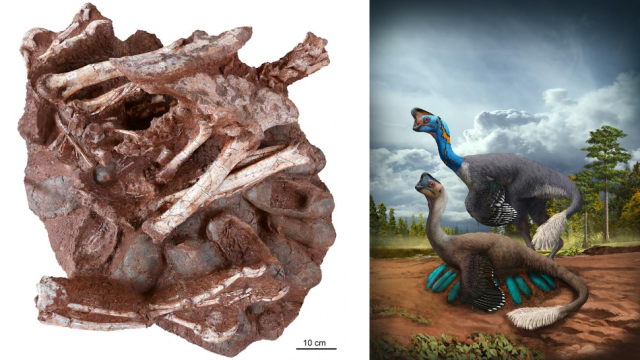Paleontologists in China have unearthed the fossil of an oviraptorosaur sitting on a nest of eggs. By itself that’s an amazing and rare discovery, but this fossil is unique in that the eggs still preserve evidence of the unhatched progeny inside.
“Here we report the first [non-avian] dinosaur fossil known to preserve an adult skeleton atop an egg clutch that contains embryonic remains,” declare the authors of a research paper published in Science Bulletin. Found in China, the fossil is expanding our understanding of oviraptorosaur behaviour and physiology, while providing further proof that non-avian dinosaurs employed bird-like brooding behaviours.
Oviraptorosaurs, also known as oviraptors, were named as such owing to an early paleontological misunderstanding of similar fossils. The name means “egg thief,” but these dinosaurs were no thieves, as it was later shown that oviraptorosaurs were the rightful owners of fossilized eggs often found next to their buried skeletal remains.
Indeed, fossils of nesting oviraptorosaurs with their eggs have been found before. What’s new here is that the dino eggs still contain evidence of the embryos inside. It’s worth pointing out that embryos within oviraptor eggs have been found before, but only in isolation. A famous example is the “Baby Louie” fossil, discovered in Henan, China, back in the 1990s.
[referenced id=”1040447″ url=”https://gizmodo.com.au/2017/05/celebrated-baby-louie-fossil-identified-as-new-dinosaur-species/” thumb=”https://gizmodo.com.au/wp-content/uploads/2017/05/10/gu6mxljpnb2owgxzm7gu-300×174.jpg” title=”Celebrated ‘Baby Louie’ Fossil Identified As New Dinosaur Species” excerpt=”The fossilised remains of a Late Cretaceous dinosaur embryo that famously graced the cover of National Geographic in the 1990s have been identified as a new species of oversized oviraptorosaur. Weighing over 1100kg as adults, these dinos were the largest roosting animals to ever appear on Earth — tending to…”]
Oviraptorosaurs were a super successful theropod dinosaur of the Cretaceous period. They varied greatly in size, with some of the largest weighing upwards of 2,425 pounds (1,100 kilograms). Common features include feathers, a long neck, wings, and beaks. These non-avian dinos were very bird-like in appearance, resembling modern ostriches. When nesting, these animals arranged their eggs in a near-perfect circle, layering their large clutches of eggs in a remarkably orderly fashion.
The newly described fossil, designated LDNHMF2008, was pulled from the Nanxiong Formation near the Ganzhou railway in southern China’s Jiangxi Province. The fossil dates towards the end of the Cretaceous period, approximately 70 million years ago. It preserves the remains of an adult mid-sized oviraptorosaur, with its skull and other skeletal features missing. The animal appears to have died while in a nesting position.
These fossilized bones were found alongside an “undisturbed clutch” of at least 24 eggs, “some of which are broken, exposing embryonic bones,” wrote the authors in the study. The researchers, led by Shundong Bi from Indiana University of Pennsylvania and Xing Xu from the Chinese Academy of Sciences, assigned the eggs to the fossil species Macroolithus yaotunensis.
Oviraptorosaur nests containing so many eggs at the same time is not uncommon, and likely an adaptation to extreme poaching by real “egg thieves.”
Microscopic analysis of the fossils showed that some embryos were in the late stages of development, and were on the verge of hatching. The authors took this as potential evidence that oviraptors were actively incubating their nests, and not just guarding them, as some paleontologists have speculated.
“In the new specimen, the babies were almost ready to hatch, which tells us beyond a doubt that this oviraptorid had tended its nest for quite a long time,” Matthew Lamanna, a paleontologist at the Carnegie Museum of Natural History and co-author of the new study, said in a statement. “This dinosaur was a caring parent that ultimately gave its life while nurturing its young.”
Other evidence affirmed this interpretation, namely an oxygen isotope analysis showing that the eggs were incubated at high, bird-like temperatures around 97 to 100 degrees Fahrenheit (36 to 38 degrees Celsius). Interestingly, the eggs were found to be in various stages of development, meaning that they hatched at different times. This is referred to as hatching asynchrony, a reproductive phenomenon seen in modern birds. The authors weren’t able to attribute a cause to the asynchronous hatching, but they presented a plausible scenario, as they write in their study:
“As in ostriches, oviraptorosaurs would have started incubation of the nest only after all eggs had been laid, such that the lower eggs, which had been laid earlier, would have been incubated for proportionally the same amount of time as the upper eggs. However, the upper eggs would have hatched earlier than the lower eggs because, being closer to the brooding adult, they would have received more heat from this individual than the lower eggs, and thus the embryos therein would have developed more rapidly.”
Finally, the scientists also detected a handful of pebbles in the dino’s abdominal region. These rocks as probably gastroliths, which animals swallow to assist with digestion. This is the first time such a thing has been documented in an oviraptorosaur, and a potential clue into their diets. That’s admittedly a ton of new insight for a single, albeit remarkable, fossil.
“It’s extraordinary to think how much biological information is captured in just this single fossil,” said Xu. “We’re going to be learning from this specimen for many years to come.”
